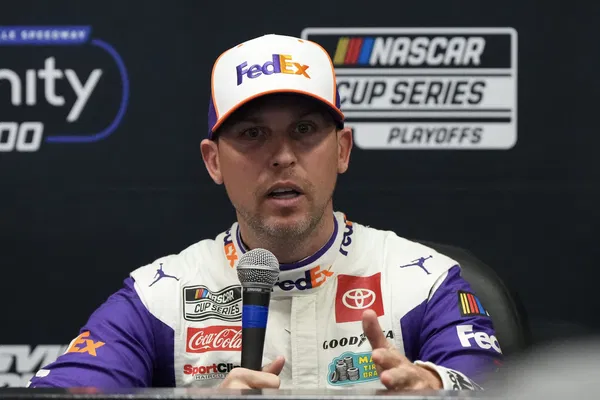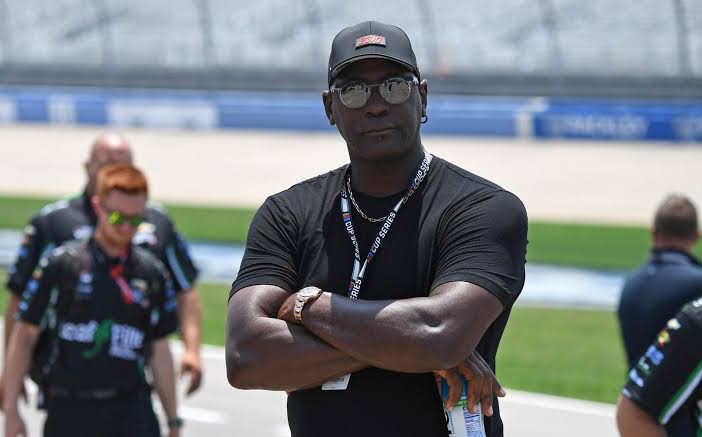An air of unspoken tension surrounds every Cup driver as they navigate this pivotal moment. The regular season, filled with 26 races of fierce competition and dreams, has come to an end, leaving only 16 contenders vying for the championship. The playoff opener at Atlanta Motor Speedway turned into a heart-pounding spectacle as drivers fought to steer clear of collisions. Denny Hamlin, however, believes that the chaos stemmed from technical difficulties rather than nerves.
While NASCAR’s signature fender-banging typically thrives on short tracks where emotions run high, Atlanta presented its own set of car troubles that influenced the drivers’ attitudes. Hamlin concluded that the anxiety often associated with such high-stakes races was not the driving force behind the turmoil in Atlanta.
Denny Hamlin pinpointed the source of the issues at Atlanta.
Chase Elliott was performing admirably alongside his Hendrick Motorsports teammates during the Quaker State 400. Unlike Kyle Larson, who exited early on lap 56, Elliott managed to stay competitive. However, a strange car handling problem arose during a pit stop, causing him to collide head-on with Austin Cindric’s vehicle. This issue resurfaced on the final lap as Joey Logano was on the verge of securing his second victory of 2024. Elliott found himself in a tangle with Chastain, which led to a chain reaction involving several cars, including Hamlin’s. Yet, Hamlin attributes this near-disastrous situation to outside influences rather than his own strategy faltering.
In a recent episode of ‘Actions Detrimental’, the Joe Gibbs Racing driver shared some insights. “There were a few reasons for this – one being that the track had lost its grip. Everyone’s car wasn’t handling as well as it had been… The leaders were running about 6-8/10ths slower than in the spring.” Denny Hamlin noted that drivers were making a concerted effort to avoid contact. “I believe the lack of major crashes was due to the necessity of maintaining distance from the car ahead or behind, as your vehicle was just out of control.”
USA Today via Reuters
However, Denny Hamlin suggested that the drivers weren’t particularly anxious, even with Atlanta being the first race of the playoffs. “I always feel that the fall races tend to be more chaotic. You have 16 drivers… and 4 of them have already missed the cut. They’re going to be aggressive. Plus, there are 20 others who have nothing to lose. They’re not in the playoffs; they’re just aiming for a win… So, I don’t think it’s a matter of playoff drivers being timid.”
This same level of aggression is generally accepted for one key reason – Atlanta is not a short track.
Brad Keselowski Dismisses the “Forced” Charter Signing Narrative, Criticizing NASCAR’s $7.7 Billion Impact
Kyle Busch Moves Past Playoff Disappointment for TV Comeback, Partnering with $4.58 Million Deal to Thrill NASCAR Fans.
Harrison Burton’s Daytona Victory Could Open Doors for a 2025 Season Opportunity
NASCAR Insider Suggests Team Owners’ ‘Fear of Retribution’ is Why Michael Jordan Lacks Supporters in Charter Dispute
In the early days of NASCAR, fans were accustomed to just one kind of track as stock cars raced around the circuit. The series initially thrived on short tracks throughout the Southeast, making venues like Bristol and Martinsville some of the oldest and most iconic. These tracks epitomize classic NASCAR, where drivers battled for position on half-mile circuits, often leading to fender-banging and post-race altercations. A recent example is the well-publicized brawl between Kyle Busch and Ricky Stenhouse Jr. at North Wilkesboro Speedway this year. In contrast, superspeedways tend to see fewer fights, as the chaotic nature of draft-driven pack racing often leads to uncontrollable situations.
Denny Hamlin highlighted this distinction while reflecting on the Atlanta race and its relatively calm post-race atmosphere. He noted, “There are more crashes on superspeedways than on short tracks. But why do we see fights at short tracks? It’s because on superspeedways, it’s more accepted when someone gets hit; it’s just part of the racing. However, on short tracks, it feels like you had control, and if someone runs into you, that’s a reason to fight.”
Overall, the Atlanta race served as an exciting kickoff to the 2024 playoffs. While drivers occasionally lost control of their cars, they managed to avoid any significant wrecks.
Denny Hamlin Rubbishes Cup Stars’ “Timidness” Behind Atlanta Escaping Massive Chaos




